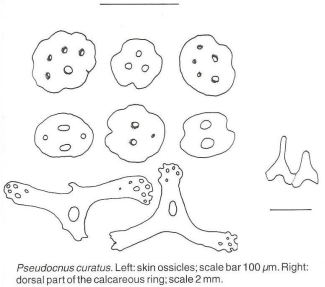curata = to care for, referring to its brooding behaviour
|
Cowles (1907) described many individuals forming black patches just below the low tide mark, clinging tightly to the rocks. As soon as the eggs are laid, the mother transfers them to the ventral surface: here, they develop directly into juveniles. The eggs are about 1 mm in diameter when laid. Associated with this species during the breeding season is a small nematode that feeds on the eggs, often destroying the whole brood. A paper by Engstrom (1974) on the biology of C. lubrica probably describes Pseudocnus curatus (Cowles). The following biology is from several papers that used the name C. lubrica. In the summer months, it feeds on particulate matter with its extended tentacles. No feeding occurs from October to March and females do not feed while brooding eggs. The diet is mostly single-celled algae.
Animals spawn from mid November to mid December around southern Vancouver Island. Males lift the anterior end off the substratum and release long strands of white sperm from genital papillae located between two of the dorsal tentacles. Sperm sink to the substratum and become entangled in the bodies of other sea cucumbers. Females raise the anterior end of the body off the substratum and arch backwards. Eggs are then spawned and roll down onto the female's ventral surface between her tube-feet. The tentacles are not used to catch the eggs; thus, many can be washed away by the current. The female then re-attaches to the rock, holding the eggs against the substratum. The large eggs (mean 973 μm) are brooded from January to March. Six weeks after spawning young cucumbers hatch, but stay with the female for another four to eight weeks.
Many species of sea stars eat P. curatus: Sand Star (Luidia foliolata), three species of sunstars (Solaster stimpsoni, S. dawsoni, S. endeca), Leather Star (Dermasterias imbricata), Six-armed Star (Leptasterias hexactis) and the Sunflower Star (Pycnopodia helianthoides). The Saddleback amphipod (Parapleustes) has been observed eating eggs. Unlike some other sea cucumbers, P. curatus does not show an escape response to any of the sea stars.
Presumably as a camouflage, adult P. curatus often attach pieces of shell, wood and other material to its dorsal surface. P. curatus' body wall is toxic to certain fish such as gunnels, Apodichthys and Pholis: a strong defence mechanism against these predators.
The parasitic gastropod, Thyonicola mortenseni, infects Pseudocnus curatus.
|
|
